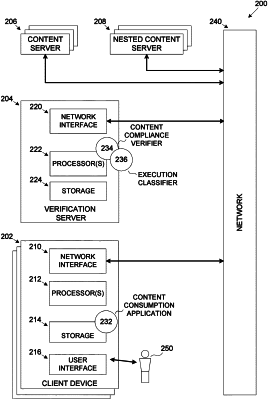| CPC G06Q 30/0275 (2013.01) [A47L 13/16 (2013.01); G06F 8/20 (2013.01); G06F 9/44526 (2013.01); G06F 9/44589 (2013.01); G06F 9/45512 (2013.01); G06Q 30/0277 (2013.01)] | 19 Claims |

|
1. A computerized method of verifying execution of advertisement (AD) content loaded by a webpage or an application executed by a client device, comprising:
using at least one processor of a client device for:
executing a webpage or an application loaded from a content server, the webpage or the application embeds at least one nesting element configured for loading nested AD content from at least one AD server, the webpage or the application embeds a host monitoring code;
executing the host monitoring code in context of the webpage or the application for:
collecting session data indicative of an execution session of the webpage or the application including execution of AD content loaded from the at least one AD server via the at least one nesting element, the context of execution of the webpage or the application is inaccessible from the context of execution of the at least one nesting element;
reducing processing, storing and networking resources in transferring at least part of the session data to at least one verification server configured to classify the execution of the AD content according to the at least part of the session data, by:
generating, in real-time, a signature for the at least part of the session data; and
transmitting, in real-time, the signature of the at least part of the session data to the at least one verification server; and
transmitting, in real-time, at least one transaction indicator of the AD content execution to at least one provider of the AD content to enable the at least one AD content provider to verify execution of the AD content according to at least one AD serving rule based on the classification of the AD content execution obtained from the at least one verification server.
|
|
18. A computerized method of classifying execution of advertisement (AD) content loaded by a webpage or an application executed by a client device, comprising:
using at least one processor of a verification server for:
receiving a signature of at least part of session data indicative of an execution session of a webpage or an application by a client device including execution of nested AD content loaded from at least one AD server using at least one nesting element embedded in the webpage or the application, the signature is generated by the client device from the session data collected by a host monitoring code executed in context of execution of the webpage or the application, the context of execution of the webpage or the application is inaccessible from the context of execution of the at least one nesting element, wherein the signature is transmitted to said verification server;
classifying the execution of the AD content according to the at least part of the session data; and
providing the classification of the AD content execution to at least one AD content provider of the AD content to enable the at least one provider to verify execution of the AD content according to at least one AD serving rule based on the classification of the AD content execution;
wherein the at least one AD content provider is informed of the execution of the AD content in real-time by the host monitoring code; and
wherein said client device generates and transmits said signature instead of transmitting said at least part of the session data to reduce processing, storing and networking resources in transferring said at least part of the session data to said verification server.
|